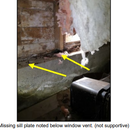Cleaning and re-insulating vented unsealed crawl space
I thought I posted, but it doesn’t look like it went through…let’s try again 🙂
My wife and I recently bought an old 1935 Tudor contructed house near the ocean in Victoria, BC in the Pacific NW. A few days in, I went and inspected the crawl space and was a little shocked. The space was covered in rodent droppings, rat and mouse I think, some of the 4×4 load bearing foundation posts had shunts to fill the gaps to the load bearing crossbeam above (picture), one load bearing 6×6 had some insect damage toward the end of the non-load bearing end (the load bearing part seemed solid, and there was some asbestos looking insulation around the water pipes. The inspector did give us a heads up on these problems, but he didn’t go through the entire crawl space. When I went in all the way, I found the foundation tapered toward the north end of the house from 4′ to 2′, making it difficult to see what the edge of the crawl space looked like. I was a little overwhelmed, but I started with testing the pipe insulation with asbestos. Here what I plan to do, but I am looking for some advice.
1. Dealing with rodents. There was tons of droppings and they looked like they got into the fiberglass insulation over head. The insect damage on the 6×6 was also disturbing. Would you hire a professional or is it doable myslelf?
2. Remediation: once rodents are gone I’m thinking of removing the poorly covered poly barrier on the floor, and rodent infected joist insulation. Again, it’s a 4′ 250 square foot crawl making it a little hard to work fast and easy. Would you suggest professionals. With the necessary precautions, would removal be safe? Also would you remove the asbestos around the piping? it doesn’t look damaged, but I may need to remove and replace insulation in the joists around it.
3. Reinsulating: It’s an open vented unsealed crawl. I’ve read a few Q&A’s here and am a little wary of trying to encapsulate this space. There is some large immovable rocks and some old stumps down there that would make sealing with poly 100% difficult. Also trying to get to some of the low areas might be difficult as well. If I were going the unsealed path, what type of insulation would you use, keeping in mind I’m in the PNW near the ocean. Thanks so much for any advice.
Regards,
Owen
GBA Detail Library
A collection of one thousand construction details organized by climate and house part












Replies
#1, yes it can be done yourself, but it’s a lot of work and there are some health dealing with the rodent droppings. At minimum, wear a tyvek suit and a respirator. There are some diseases that humans can get from coming into contact with droppings from infected rodents.
Replacing the support column probably isn’t that big a deal, but you need to know what you’re doing. If you have ANY doubt here, hire someone. The risk you take trying to do it yourself without knowing how is that the floor collapses on you an traps you in the crawlspace.
#2, I’d replace the old poly with new reinforced crawl space barrier. All the reinforced barrier is is thicker (usually at least 10 mil) polyethylene with a nylon mesh inside to help prevent tears. This part isn’t too difficult to do yourself, but you’ll need the right materials and you should try to clean up and level the floor of the crawl space as much as possible before you put in the new liner.
DO NOT REMOVE THE ASBESTOS YOURSELF. Asbestos only becomes a health hazard when you disturb it and breath the dust. I’d either higher an abatement company if you want to remove it, or paint it with an encapsulant to limit the possibility of any dust coming off.
#3, this is more complex. Usually rigid foam panels are used to insulate the foundation walls, but this doesn’t always work if you have something less than flat like a stone foundation. Sometimes spray foam is best for this.
Bill
Thanks for the reply, Bill. I think after the rodent removal, I'm going to leave the asbestos in place and just do a removal of old poly and insulation myself with the help of a respirator and tyvek suit like you suggested. Still looking into what kind of insulation I want to replace it with...